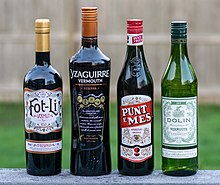
Vermouth (/vərˈmuːθ/, UK also /ˈvɜːməθ/)[1][2] is an aromatized fortified wine, flavoured with various botanicals (roots, barks, flowers, seeds, herbs, and spices) and sometimes colored. The modern versions of the beverage were first produced in the mid to late 18th century in Turin, Italy.[3] While vermouth was traditionally used for medicinal purposes, it was later served as an apéritif, with fashionable cafés in Turin serving it to guests around the clock.[3] In the late 19th century, it became popular with bartenders as a key ingredient for cocktails,[4][5] such as the martini, the Manhattan, the Rob Roy, and the Negroni. In addition to being consumed as an aperitif or cocktail ingredient, vermouth is sometimes used as an alternative to white wine in cooking.
Historically, there have been two main types of vermouth: sweet and dry.[6] Responding to demand and competition, vermouth manufacturers have created additional styles, including extra-dry white, sweet white (blanc or bianco), red (rosso), amber and rosé.[7][5]
Vermouth is produced by starting with a base of neutral grape wine or unfermented wine must. Each manufacturer adds additional alcohol and a proprietary mixture of dry ingredients, consisting of aromatic herbs, roots, and barks, to the base wine, base wine plus spirit, or spirit only – which may be redistilled before adding to the wine or unfermented wine must. After the wine is aromatized and fortified, the vermouth is sweetened with either cane sugar or caramelized sugar, depending on the style.[8]
Italian and French companies produce most of the vermouth consumed throughout the world.[3] Nevertheless, in 2022 an Australian company won a gold medal for its extra-dry vermouth at the World Vermouth Awards in London.[citation needed] Further, a Canadian company was a double winner in 2023, the first producer outside Europe to be judged "best" for both the dry and semi-sweet categories.[9][10]
- ^ Jones & Gimson 1977.
- ^ Cite error: The named reference
oedwas invoked but never defined (see the help page). - ^ a b c Brown & Miller 2011.
- ^ Cite error: The named reference
pattersonwas invoked but never defined (see the help page). - ^ a b Cite error: The named reference
clarkewas invoked but never defined (see the help page). - ^ Cite error: The named reference
boydwas invoked but never defined (see the help page). - ^ Cite error: The named reference
styleswas invoked but never defined (see the help page). - ^ Cite error: The named reference
bostonwas invoked but never defined (see the help page). - ^ Cite error: The named reference
klosterwas invoked but never defined (see the help page). - ^ Cite error: The named reference
tastewas invoked but never defined (see the help page).